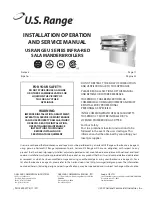
HAMWORTHY HEATING LTD. PUREWELL AUTOMATIC IGNITION 500001035/G
7
8.0
WATER CIRCULATION SYSTEM
8.1
General
The Purewell Cast Iron Boiler has a low water content
and the requirements of minimum water flow are given
in
Section 8.8: Minimum Water Flow Rates
and
Figure No. 2. Recommendations for the water
circulation system are given in
BS 6644
and
CP 342
.
The following notes are of particular importance: -
1)
In a combined central heating and hot water system,
the hot water storage vessel must be of the indirect
cylinder or calorifier type. The hot water storage vessel
should be insulated preferably with not less than 75mm
(3 in) thick mineral fibre, or its thermal equivalent.
2)
Circulating pipework not forming part of the useful
heating surface should be insulated to help prevent
heat loss and possible freezing, particularly where
pipes are run through roof spaces and ventilated
cavities. Cisterns situated in areas, which may be
exposed to freezing conditions, should also be
insulated. Insulation exposed to the weather should
be rendered waterproof.
3)
Draining taps must be located in accessible
positions which permit the draining of the whole
system, including the boiler and hot water storage
vessel.
4)
Each boiler has one 2" BSP female flow and one
2" BSP female return tapping. Flow and return
headers should connect boilers but sufficient length
of connecting pipe should be allowed to clear the
casing before connecting into the headers. The
headers should be connected to the system in a
“reverse return” arrangement (the water flow in each
header is in the same direction) to ensure equal flow
in each module. Figure No. 8 shows typical layout.
8.2
Pressure Relief Valve (Safety Valve)
Each boiler, or in the case of a modular installations,
each bank of boilers, must be fitted with a pressure
relief valve to
BS 759
or
BS 6759
Part 1(
ISO 4126
)
and sized as shown in
BS 6644
.
BS 6644
provides comprehensive information for the
selection and location of safety valves and attention
is drawn to the higher capacity requirements of safety
valves for pressurised hot water systems.
8.3
Open Vent and Cold Feed Pipe
(See
BS 6644
for further information.)
Every boiler or group of boilers should have an open
vent pipe and cold feed pipe installed between the
boiler and the first water isolating valve. The minimum
bore (mm) of these pipes per installation is as follows:-
The vent pipe must rise continually, it must not be
valved except by a design which when closed for
maintenance ensures the boiler is open to
atmosphere. The pipe shall be protected against
freezing where this might occur.
8.4
Altitude Gauge (Water Pressure Gauge)
Every boiler or group of boilers should be provided
with a gauge complete with isolating cock. See Figure
No. 8 for typical position.
8.5
Thermometer
See Figure No. 8 for typical position. A thermometer
complete with pocket should be fitted in the pipework
to indicate water flow temperature.
8.6
Drain Valves
Each boiler should have a
1
/
2
” NB drain valve (not
H.H.L. supply) fitted to drain the boiler only. The
heating system in total should have drain valves as
recommended by
BS 6644
. See Figure No. 8 for
recommended positions.
8.7
Circulating Pump
One or more circulating pumps will be required to
circulate water around the boilers and heating system.
Figure No. 1 shows the hydraulic resistance of the
boiler. The pump should be sited to facilitate servicing.
It is important to note that when Purewell boilers are
used to replace boilers on an existing system, the
pumps should be checked for performance against
the new boiler waterside pressure drop to ensure that
the minimum flow rate can be obtained. It is also
important that the existing system be flushed through
twice to remove any loose matter, which may have
accumulated. If in any doubt regarding the cleanliness
of the system, a coarse filter should be fitted in the
return pipework to the boilers.
8.8
Minimum Water Flow Rates
Minimum water flow rates are shown in Figure No. 2.
These flow rates should be maintained through the
boiler at all times whilst the boiler is firing. If the water
flow rate is allowed to fall below the minimum, the
boiler heat exchanger could fail due to the resultant
scale formation. Particular attention should be paid
to the restriction of external flow circuits during periods
of low heat demand.














































